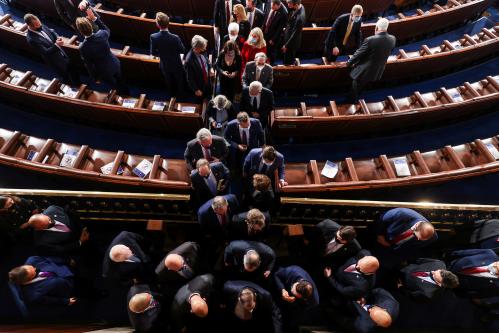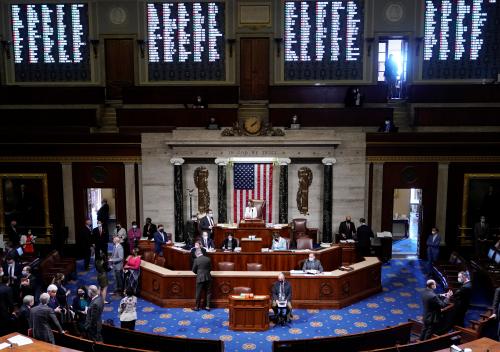With the 2022 midterm elections on the horizon, Democrats’ unified control of the House, Senate, and the presidency may be nearing its end. Investigations of the executive branch by House committees occur more often when the chamber is controlled by the opposite party from the White House. If Republicans take control of the House, then, what might we expect to see in terms of investigative trends?
Data from the 116th and 117th Congresses from the Brookings Oversight Tracker can help shed light on this question. The 116th Congress saw divided government, while the 117th has proceeded under unified Democratic control. Here, we examine 20 House committees that existed in both Congresses; have jurisdictions that involve overseeing executive branch operations; and that had significant committee activity (20 or more letters/hearings) in the first 18 months of session (through June of the second year).
Calculating the share of each committee’s activities that constituted oversight of the executive branch, we found that the typical House committee devoted less attention to overseeing the executive branch in the 117th Congress than in the 116th; the median share of activity that involved oversight of the executive branch was 24.9% in the 117th Congress, compared to the 36.9% in the 116th. A majority (15 of the 20) of committees included in this analysis saw a decrease in oversight activity in the 117th House, with the largest shifts coming in the Energy and Commerce, Intelligence, and Judiciary Committees. Only three committees in the 117th House increased their oversight activity by 10% or more compared to in the 116th. Explanations for this increase in oversight activity varied by committee: the Armed Services Committee, for example, held more general oversight hearings of the military, while the House Administration Committee sent letters conducting oversight of election disinformation and the January 6th Attack following the 2020 election.
Table 1: House Oversight of the Executive Branch in the 116th and 117th Congresses
| House Committee* |
116th Rate of Executive Oversight (Divided Government) |
117th Rate of Executive Oversight (Unified Government) |
Difference in Rates (117th Congress – 116th Congress |
| Agriculture | 29.8% | 22.9% | -6.9% |
| Appropriations | 21.9% | 19.9% | -2.1% |
| Armed Services | 18.4% | 32.1% | 13.8% |
| Budget | 11.8% | 0% | -11.8% |
| Education and Labor | 50.3% | 28.1% | -22.2% |
| Energy and Commerce | 44.2% | 12.8% | -31.4% |
| Financial Services | 23.6% | 6.4% | -17.2% |
| Foreign Affairs | 32.6% | 9.7% | -22.9% |
|
Homeland Security
|
36.9% | 43.4% | 6.5% |
| House Administration | 17.9% | 28.0% | 10.1% |
| Judiciary | 61.7% | 28.6% | -33.1% |
| Natural Resources | 39.3% | 9.7% | -29.6% |
| Oversight and Reform | 60.8% | 40.5% | -20.3% |
| Science, Space, and Technology | 40.2% | 22.0% | -18.2% |
| Small Business | 21.6% | 32.2% | 10.6% |
| Transportation | 37.3% | 18.1% | -19.2% |
| Veterans’ Affairs | 50.5% | 36.8% | -13.8% |
| Ways and Means | 36.8% | 26.8% | -10.0% |
| Intelligence | 64.9% | 33.3% | -31.6% |
| Climate Crisis | 0.0% | 5.3% | 5.3% |
| Median | 36.9% | 24.9% | -15.7% |
If congressional committees did not devote as much attention to executive oversight in 2021 and 2022 as in 2019 and 2020, then what did they spend their time on? The House Committee on Energy and Commerce, for example, conducted significant oversight, but into areas other than executive branch actions. The committee sent out 55 letters on December 1st, 2021, to each U.S. Olympic sport team reminding them to comply with federal laws and report sexual abuse. In another investigation, the committee sent letters to four major manufacturers of vaping and nicotine products on March 22nd, 2022. These letters requested information about company knowledge of the negative health effects of their products and asked for details about their marketing campaigns. This has been an ongoing area of inquiry in the 117th Congress, going back to last June when the Subcommittee on Economic and Consumer Policy held a hearing on the FDA’s response to youth vaping.
The House Committee on Oversight and Reform similarly engaged in notable investigations—but on topics outside of the executive branch. For example, on May 12, 2022, the Committee sent four letters to social media companies encouraging them to preserve content on their platforms that could be used as evidence of Russian atrocities in Ukraine. The letters warned Chief Executive Officers at Facebook, Twitter, YouTube, and TikTok that their companies’ use of automated systems to remove graphic content could potentially lead to the deletion of evidence of human rights violations in Ukraine.
Although House committees have devoted a smaller share of their efforts to overseeing the executive branch in the 117th Congress, oversight of the Biden administration has certainly continued. The House Foreign Affairs Committee, for example, has explored the U.S. withdrawal from Afghanistan at both the full and subcommittee level. The executive branch’s continuing response to the COVID-19 pandemic was also a continued target of oversight efforts, including by the Energy and Commerce Committee.
On the whole, however, House committees have tended to devote less time to overseeing the executive branch under unified government in 2021 and 2022 than under divided control in the previous two years. This trend—consistent with historical evidence—suggests that a return to a partisan split between the House and the White House in 2023 would likely bring a resurgence of oversight activity targeted at the Biden administration.
The Brookings Institution is committed to quality, independence, and impact.
We are supported by a diverse array of funders. In line with our values and policies, each Brookings publication represents the sole views of its author(s).










Commentary
House oversight of the executive branch—What did the 116th and 117th Congresses spend their time on?
October 21, 2022